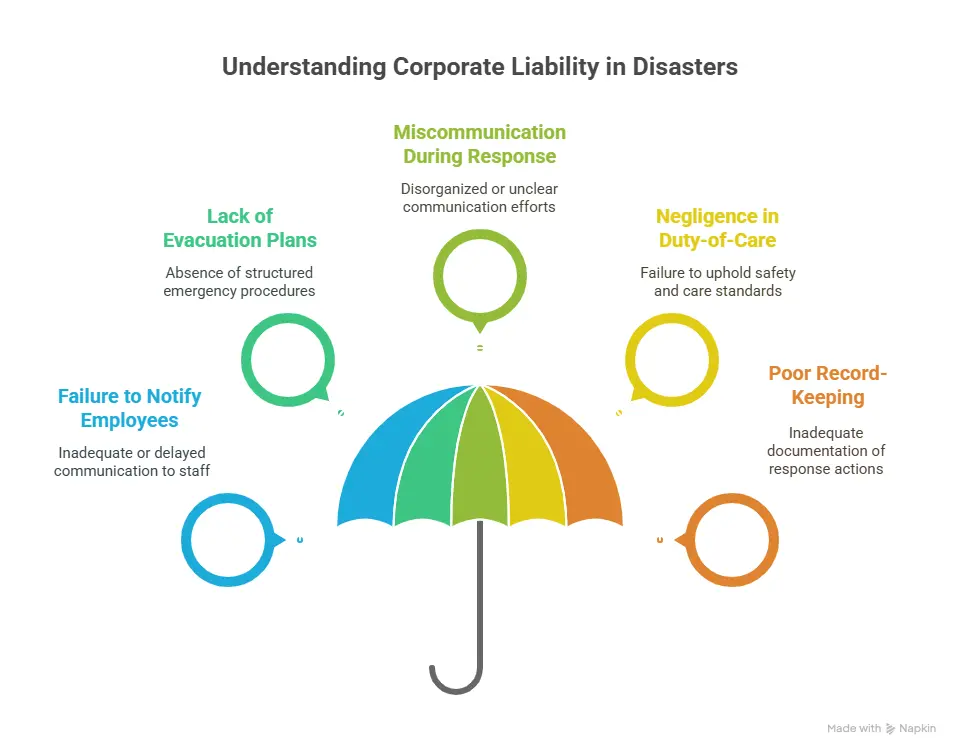In an era of increasing natural-related disasters, cyberattacks, workplace violence, and utility failures, businesses are under more pressure than ever to respond quickly and effectively when crises strike.
While the top priority during any emergency is protecting human life—particularly the safety and well-being of employees—there is also a critical business imperative at stake: limiting liability exposure.
Failure to prepare for and respond to emergencies doesn’t just endanger lives—it opens the door to liability lawsuits, regulatory penalties, business disruption, and long-term reputational damage.
That’s why more companies are turning to emergency response technology and rapid response software to protect both people and assets.
Why Corporate Liability During Disasters is a Growing Threat
When disaster hits—whether it’s a fire, earthquake, data breach, or workplace threat—companies can face lawsuits from employees, customers, or even regulatory agencies if it’s shown they failed to adequately prepare or respond.
Common causes of liability include:
- Failure to notify employees in time
- Lack of evacuation plans or training
- Miscommunication or chaos during response
- Negligence in duty-of-care obligations
- Poor record-keeping and documentation of response efforts

Even when loss of life or injury is avoided, companies may still face liability risk tied to emotional distress, exposure to hazardous conditions, or lost wages.
From a business standpoint, there’s also the question of how to establish proper emergency preparedness without compromising productivity.
The Role of Crisis Response Technology in Limiting Liability Risk
Modern crisis response technology plays a critical role in mitigating liability during disasters.
Here’s how:
1. Real-Time Communication Tools
Effective communication is the cornerstone of any crisis response.
Emergency response platforms allow for mass notifications, two-way communication, and automated alerts to keep all employees informed across multiple channels—email, SMS, mobile apps, and even desktop pop-ups.
This helps eliminate confusion and ensures legal compliance with emergency communication standards.
2. Automated Incident Reporting and Documentation
In the aftermath of a disaster, businesses need to prove what actions they took and when. Rapid response software captures critical data—time-stamped communications, employee check-ins, and task completions—to provide defensible documentation.
This record can protect your business in court and during regulatory reviews.
3. Employee Safety Status Tracking
Technology that enables real-time tracking of employee status and location can dramatically improve outcomes during a disaster.
It also supports your legal obligation to account for personnel, reducing the likelihood of litigation tied to neglect or oversight.
4. Compliance and Preparedness Audits
Most emergency response technology platforms include tools for regular audits, drills, and preparedness assessments.
This not only improves actual readiness but provides documented proof of OSHA compliance and other regulatory requirements—vital in minimizing liability exposure.
5. Centralized Control and Accountability
Cloud-based platforms provide a single command-and-control interface for decision-makers to monitor and manage the response in real time.
With better coordination and visibility, you minimize the risk of errors, miscommunications, and missed responsibilities—all of which can fuel legal claims.
Protecting People Is the Priority—But So Is Protecting the Business
Ultimately, keeping employees safe is not only a moral and legal responsibility—it’s also a smart business strategy.
When your people are protected, and your response is organized and effective, the likelihood of legal fallout drops significantly. The reputational value of being seen as a proactive, responsible employer also enhances employee trust and customer confidence.
Building Safety Solutions is a company that has long developed cutting-edge emergency response technologies like BSS Guardian to protect people and limit liability risk.
In contrast, being caught off-guard or mishandling an emergency can lead to:
- Wrongful death or personal injury lawsuits
- Class action claims from affected employees or customers
- Regulatory fines from OSHA, FEMA, or state agencies
- Long-term reputational and financial damage
Future-Proofing Your Business Against Liability
Preparedness is no longer optional—it’s expected.
Crisis response technology is one of the most cost-effective ways to fulfill your duty of care, reduce your liability risk, and preserve your operations and reputation in the face of disaster.
By investing in robust rapid response software, your company sends a clear message: “We take safety seriously—and we’re ready.”
Frequently Asked Questions About Crisis Response Technology & Corporate Liability
Understanding how emergency response technology and rapid response software can protect your business is essential in today’s risk landscape. Below are some of the most common questions business leaders ask when exploring ways to limit liability exposure during a disaster.
What is emergency response technology, and how does it reduce corporate liability?
Emergency response technology refers to digital platforms that automate communications, coordinate response efforts, and track employee safety during a crisis. It helps reduce liability risk by ensuring compliance, preventing harm, and documenting your actions in real time.
How does rapid response software differ from traditional emergency plans?
Traditional emergency plans are often paper-based or static. Rapid response software is dynamic and digital—providing real-time updates, alerts, and task management that can be executed immediately. It reduces liability by enabling faster, more organized crisis management.
Can this technology help during all types of disasters?
Yes. From natural disasters and workplace violence to cyberattacks and medical emergencies, crisis response technology is built to handle diverse scenarios. Its adaptability ensures that your business is protected across a wide range of threats.
Is this software only necessary for large corporations?
No. Small and mid-sized businesses often face the same risks—sometimes with fewer resources. Scalable emergency response technology makes it affordable and practical for organizations of any size to reduce liability exposure and improve readiness.
What regulations does emergency software help us comply with?
Platforms are designed to support:
- OSHA emergency preparedness standards
- Local and federal workplace safety laws
- Industry-specific compliance (e.g., HIPAA, NERC, PCI-DSS)
- Internal risk and audit policies
Proper use can help demonstrate legal compliance and significantly reduce liability risk.
Can I track employee safety in real time during a disaster?
Absolutely. Many solutions feature employee check-in systems, geolocation tracking, and status dashboards. This capability helps ensure everyone is accounted for and supports your duty-of-care obligations, helping to prevent or defend against lawsuits.
Does using this software eliminate all liability?
Not entirely—but it dramatically reduces liability exposure by demonstrating proactive planning, regulatory compliance, and real-time protection of human life. It’s a cornerstone of a sound corporate risk management strategy.
Want help implementing crisis response technology that protects your business and reduces liability? Contact us today for a free demo or consultation.
About Building Safety Solutions
Building Safety Solutions, Inc. (BSS) is the worldwide leader in providing emergency preparedness software, disaster management technology, and rapid response software. By protecting the life of your business, our proprietary technology limits legal liability exposure, secures your brand and saves the lives of your employees.
Contact us today for more information and a free consultation to learn how to protect your business today and tomorrow.

